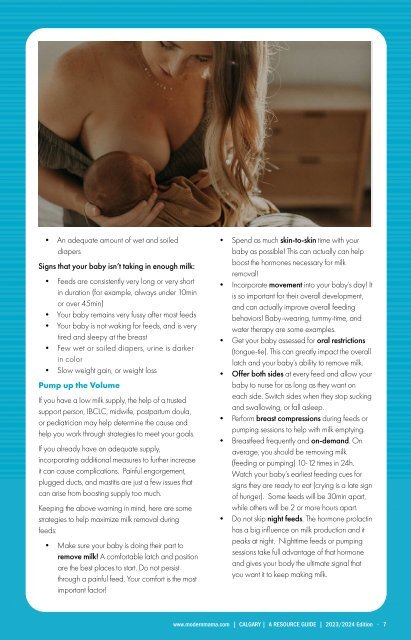Calgary Baby Guide 2023-2024
You also want an ePaper? Increase the reach of your titles
YUMPU automatically turns print PDFs into web optimized ePapers that Google loves.
• An adequate amount of wet and soiled<br />
diapers<br />
Signs that your baby isn’t taking in enough milk:<br />
• Feeds are consistently very long or very short<br />
in duration (for example, always under 10min<br />
or over 45min)<br />
• Your baby remains very fussy after most feeds<br />
• Your baby is not waking for feeds, and is very<br />
tired and sleepy at the breast<br />
• Few wet or soiled diapers, urine is darker<br />
in color<br />
• Slow weight gain, or weight loss<br />
Pump up the Volume<br />
If you have a low milk supply, the help of a trusted<br />
support person, IBCLC, midwife, postpartum doula,<br />
or pediatrician may help determine the cause and<br />
help you work through strategies to meet your goals.<br />
If you already have an adequate supply,<br />
incorporating additional measures to further increase<br />
it can cause complications. Painful engorgement,<br />
plugged ducts, and mastitis are just a few issues that<br />
can arise from boosting supply too much.<br />
Keeping the above warning in mind, here are some<br />
strategies to help maximize milk removal during<br />
feeds:<br />
• Make sure your baby is doing their part to<br />
remove milk! A comfortable latch and position<br />
are the best places to start. Do not persist<br />
through a painful feed. Your comfort is the most<br />
important factor!<br />
• Spend as much skin-to-skin time with your<br />
baby as possible! This can actually can help<br />
boost the hormones necessary for milk<br />
removal!<br />
• Incorporate movement into your baby’s day! It<br />
is so important for their overall development,<br />
and can actually improve overall feeding<br />
behaviors! <strong>Baby</strong>-wearing, tummy-time, and<br />
water therapy are some examples.<br />
• Get your baby assessed for oral restrictions<br />
(tongue-tie). This can greatly impact the overall<br />
latch and your baby’s ability to remove milk.<br />
• Offer both sides at every feed and allow your<br />
baby to nurse for as long as they want on<br />
each side. Switch sides when they stop sucking<br />
and swallowing, or fall asleep.<br />
• Perform breast compressions during feeds or<br />
pumping sessions to help with milk emptying.<br />
• Breastfeed frequently and on-demand. On<br />
average, you should be removing milk<br />
(feeding or pumping) 10-12 times in 24h.<br />
Watch your baby’s earliest feeding cues for<br />
signs they are ready to eat (crying is a late sign<br />
of hunger). Some feeds will be 30min apart,<br />
while others will be 2 or more hours apart.<br />
• Do not skip night feeds. The hormone prolactin<br />
has a big influence on milk production and it<br />
peaks at night. Nighttime feeds or pumping<br />
sessions take full advantage of that hormone<br />
and gives your body the ultimate signal that<br />
you want it to keep making milk.<br />
www.modernmama.com | CALGARY | A RESOURCE GUIDE | <strong>2023</strong>/<strong>2024</strong> Edition • 7










